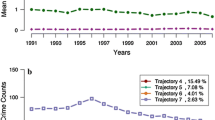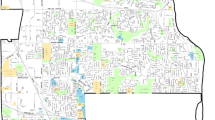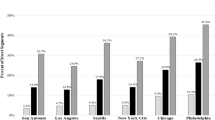Abstract
Objectives
Investigate the spatial concentrations and the stability of trajectories for disaggregated crime types on street segments and intersections in Vancouver, Canada.
Methods
A longitudinal analysis of 16 years of crime data using street segments and intersections as the units of analysis. We use the k-means non-parametric cluster analysis technique considering eight crime types: assault, burglary, robbery, theft, theft of vehicle, theft from vehicle, other, and total crime.
Results
The overall results for the individual crime types versus overall crime are similar: crime is highly concentrated regardless of crime type, most street segment and intersection trajectories are stable over time with the others decreasing, and most decreasing trajectories are in the same general areas. However, there are notable differences across crime types that need to be considered when attempting to understand spatial pattern changes and implement crime prevention initiatives.
Conclusions
The law of crime concentration at places holds in Vancouver, Canada for disaggregated crime types in the context of spatial concentrations and their stability over time. However, notable differences exist across crime types that should be accounted for when developing theory or policy.







Similar content being viewed by others
Notes
References
Andresen MA (2006) Crime measures and the spatial analysis of criminal activity. Br J Criminol 46:258–285
Andresen MA (2007) Location quotients, ambient populations, and the spatial analysis of crime in Vancouver, Canada. Environ Plann A 39:2423–2444
Andresen MA, Jozaghi E (2012) The point of diminishing returns: an examination of expanding Vancouver’s Insite. Urban Stud 49:3531–3544
Andresen MA, Linning SJ (2012) The (in)appropriateness of aggregating across crime types. Appl Geogr 35:275–282
Andresen MA, Malleson N (2011) Testing the stability of crime patterns: implications for theory and policy. J Res Crime Delinq 48:58–82
Andresen MA, Malleson N (2013) Spatial heterogeneity in crime analysis. In: Leitner M (ed) Crime modeling and mapping using geospatial technologies. Springer, New York, pp 3–23
Andresen MA, Linning SJ, Malleson N (2016) Crime at places and spatial concentrations: exploring the spatial stability of property crime in Vancouver BC, 2003–2013. J Quant Criminol. doi:10.1007/s10940-016-9295-8
Andruff H, Carraro N, Thompson A, Gaudreau P, Louvet B (2009) Latent class growth modelling: a tutorial. Tutor Quant Methods Psychol 5:11–24
Boyce J, Cotter A, Perreault S (2014) Police-reported crime statistics in Canada, 2013, statistics Canada. Canadian Centre for Justice Statistics, Ottawa
Braga A, Hureau DM, Papachristos AV (2010) The concentration and stability of gun violence at micro places in Boston, 1980–2008. J Quant Criminol 26:33–53
Braga A, Hureau DM, Papachristos AV (2011) The relevance of micro places to citywide robbery trends: a longitudinal analysis of robbery incidents at street corners and block faces in Boston. J Res Crime Delinq 48:7–32
Calinski T, Harabasz J (1974) A dendrite method for cluster analysis. Commun Stat 3:1–27
Clarke RVG (1980) Situational crime prevention: theory and practice. Br J Criminol 20:136–147
Clarke RV (1983) Situational crime prevention: its theoretical basis and practical scope. Crime Justice 4:225–256
Clarke RV (2012) Opportunity makes the thief. Really? And so what? Crime Sci 1: Article 3
Curman ASN, Andresen MA, Brantingham PJ (2015) Crime and place: a longitudinal examination of street segment patterns in Vancouver, BC. J Quant Criminol 31:127–147
Farrell G, Tseloni A, Mailley J, Tilley N (2011) The crime drop and the security hypothesis. J Res Crime Delinq 48:147–175
Farrell G, Tilley N, Tseloni A (2015) Why the crime drop? Crime Justice 43:421–490
Genolini C, Falissard B (2010) KmL: k-means for longitudinal data. Comput Stat 25:317–328
Genolini C, Alacoque X, Sentenac M, Arnaud C (2015) kml and kml3d: R packages to cluster longitudinal data. J Stat Softw 65:1–34
Groff ER, Weisburd D, Yang S-M (2010) Is it important to examine crime trends at a local ‘‘micro’’ level? A longitudinal analysis of street to street variability in crime trajectories. J Quant Criminol 26:7–32
Guerry A-M (1832) La statistique compare de l’état de l’instruction et du nombre des crimes. Revue Encyclopédique 55:414–424
Guerry A-M (1833) Essai sur la statistique morale de la France. Crochard, Paris
Huizinga D, Esbensen F, Weiher AW (1991) Are there multiple paths to delinquency? J Crim Law Criminol 82:83–118
Kinney JB, Brantingham PL, Wuschke K, Kirk MG, Brantingham PJ (2008) Crime attractors, generators and detractors: land use and urban crime opportunities. Built Environ 34:62–74
Klinger DA, Bridges GS (1997) Measurement error in calls-for-service as an indicator of crime. Criminology 35:705–726
Kong R (1997) Canadian crime statistics, 1996, statistics Canada. Canadian Centre for Justice Statistics, Ottawa
Levitt SD (2004) Understanding why crime fell in the 1990s: four factors that explain the decline and six that do not. J Econ Perspect 18:163–190
Melo SN, Matias LF, Andresen MA (2015) Crime concentrations and similarities in spatial crime patterns in a Brazilian context. Appl Geogr 62:314–324
Mishra S, Lalumière M (2009) Is the crime drop of the 1990s in Canada and the USA associated with a general decline in risky and health-related behavior? Soc Sci Med 68:39–48
Mowder MH, Cummings JA, McKinney R (2010) Resiliency scales for children and adolescents: profiles of juvenile offenders. J Psychoeduc Assess 28:326–337
Nagin DS, Land KC (1993) Age, criminal careers and population heterogeneity: specification and estimation of a nonparametric, mixed Poisson model. Criminology 31:327–362
Ouimet M (2002) Explaining the American and Canadian crime “drop” in the 1990s. Can J Criminol 44:33–50
Quetelet LAJ (1842) A treatise on man and the development of his faculties. W. and R. Chambers, Edinburgh
Quetelet LAJ [1831] (1984) Research on the propensity for crime at different ages (trans: Sylvester SF). Anderson Publishing, Cincinnati
Ratcliffe JH (2004) Geocoding crime and a first estimate of a minimum acceptable hit rate. Int J Geogr Inf Sci 18:61–72
Savoie J (2002) Crime statistics in Canada, 2001, statistics Canada. Canadian Centre for Justice Statistics, Ottawa
Sherman LW, Gartin PR, Buerger ME (1989) Hot spots of predatory crime: routine activities and the criminology of place. Criminology 27:27–56
Silver W (2007) Crime statistics in Canada, 2006, statistics Canada. Canadian Centre for Justice Statistics, Ottawa
Tseloni A, Mailley J, Farrell G, Tilley N (2010) Exploring the international decline in crime rates. Eur J Criminol 7:375–394
Wallace M (2003) Crime statistics in Canada, 2002, statistics Canada. Canadian Centre for Justice Statistics, Ottawa
Wallace M (2004) Crime statistics in Canada, 2003, statistics Canada. Canadian Centre for Justice Statistics, Ottawa, ON
Weisburd D (2015) The law of crime concentration and the criminology of place. Criminology 53:133–157
Weisburd D, Amram S (2014) The law of concentrations of crime at place: the case of Tel Aviv-Jaffa. Police Pract Res 15:101–114
Weisburd D, Bushway S, Lum C, Yang S-M (2004) Trajectories of crime at places: a longitudinal study of street segments in the City of Seattle. Criminology 42:283–321
Weisburd D, Bruinsma GJN, Bernasco W (2009a) Units of analysis in geographic criminology: Historical development, critical issues, and open questions. In: Weisburd D, Bernasco W, Bruinsma GJN (eds) Putting crime in its place: Units of analysis in geographic criminology. Springer, New York, pp 3–31
Weisburd D, Morris NA, Groff ER (2009b) Hot spots of juvenile crime: a longitudinal study of street segments in Seattle, Washington. J Quant Criminol 25:443–467
Weisburd D, Groff ER, Yang S-M (2012) The criminology of place: Street segments and our understanding of the crime problem. Oxford University Press, New York
Wheeler AP, Worden RE, McLean SJ (2015) Replicating group-based trajectory models of crime at micro-places in Albany, NY. J Quant Criminol. doi:10.1007/s10940-015-9268-3
Wolfgang ME, Figlio RM, Sellin T (1972) Delinquency in a Birth Cohort. University of Chicago Press, Chicago
Acknowledgments
We would like to thank three anonymous reviewers whose comments have made this a better paper.
Author information
Authors and Affiliations
Corresponding author
Rights and permissions
About this article
Cite this article
Andresen, M.A., Curman, A.S. & Linning, S.J. The Trajectories of Crime at Places: Understanding the Patterns of Disaggregated Crime Types. J Quant Criminol 33, 427–449 (2017). https://doi.org/10.1007/s10940-016-9301-1
Published:
Issue Date:
DOI: https://doi.org/10.1007/s10940-016-9301-1




